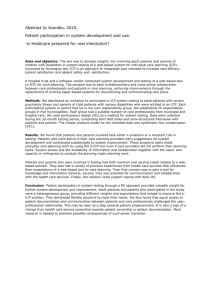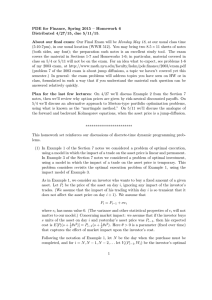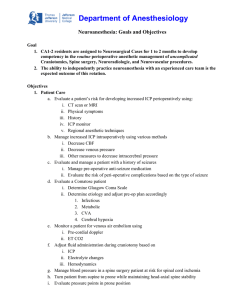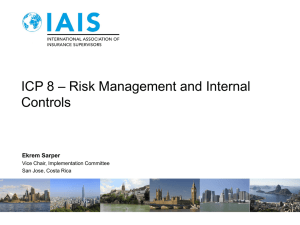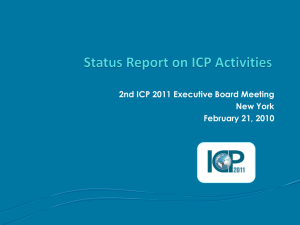File - Investor Confidence Project
advertisement
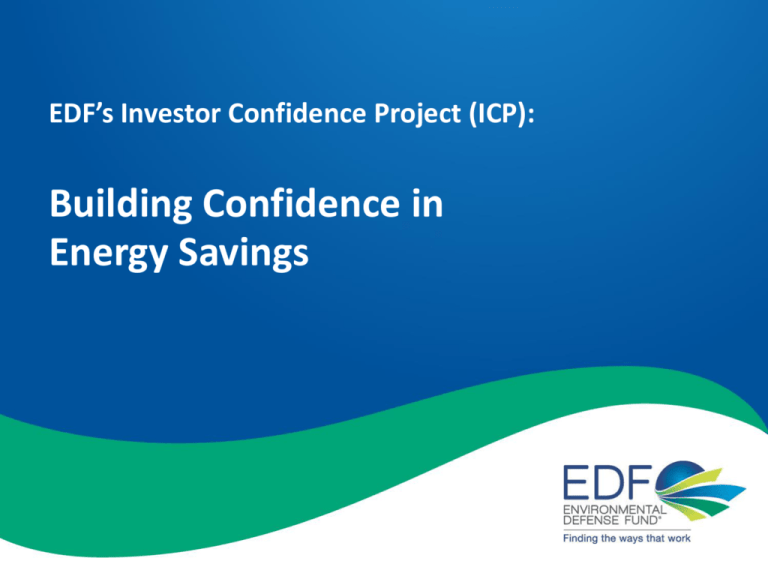
EDF’s Investor Confidence Project (ICP): Building Confidence in Energy Savings The Investor Confidence Project • Efficiency Lifecycle Framework 1. Baselining • • 2. 3. 4. 5. Core Requirements Rate Analysis, Demand, Load Profile, Interval Data Savings Projections Design, Construction, Commissioning Ongoing Commissioning Measurement and Verification (M&V) – Enables a clear definition of the complete process necessary to ensure performance – Can house multiple standards for different building types and business models • Energy Efficiency Performance Protocol - Large Commercial (EEPP-LC) – Create an accepted best practice approach to Large Commercial building retrofitting – Uses existing and accepted industry practices and standards – Define “appraisal pack” of documentation for EE Performance – A standardized approach to delivering investment ready project to market Managing Project Risk Factors Performance Risk Asset Risk Credit Risk Market Actors • Building Owners – Achieve acceptable ROI on their specific project – Access financing • Origination Partners – Be able to close business leveraging ESAs and other products – Allow for distributed models • Energy Service Companies – Deal flow with reasonable transaction costs through channels – Manageable performance risk Market Actors • Financial Markets – Ensure performance risk is managed correctly (by someone) – Correlate project performance with asset risk – Create large pools of consistent projects • Insurance Industry – Underwrite performance risk with a narrower band • Utilities / Capacity Markets – Bet on demand reductions to meet capacity needs, and achieve regulatory mandates – Manage EM&V risk – Treat Energy Efficiency as resource procurement – Access forward capacity markets • Carbon Markets? – AB32 in California Performance Risk Barriers • Project Demand – Lack of standards puts engineering overhead on each firm – Channels are rendered ineffective – Lack of transparency has created market inefficiencies • Savings Uncertainty – Lots of winners and losers (variance), creating uncertainty – Many approaches to savings estimation, installation, commissioning, etc. – Averages penalize performing projects, and incentivize low quality • Actuarial Data – Lack of quality and quantity of data results in a high degree of uncertainty – Getting data from industry, finance, and the energy sector is challenging – Data does not describe all factors that impact performance Energy Efficiency Performance Protocol First Energy Efficiency Performance Protocol designed for Large Commercial projects (EEPP-LC): • Large Buildings, where the cost of improvements and size of savings justifies greater time and effort in pre- and post- development energy analysis • Whole Building Retrofits, projects that involve multiple measures with interactive effects rather than a single piece of equipment • High Performing Projects, projects with sufficient depth necessary for pre- and post-retrofit meter data yields (i.e., savings can be anticipated to be of greater magnitude than noise) Energy Efficiency Performance Protocol • Required Elements • Required Procedures • Required Documentation Energy Efficiency Performance Protocol • Required Elements • Required Procedures • Required Documentation Project Performance Package EEPP standard documentation similar to an appraisal package: • Prescribed methods • Consistent taxonomy • Accepted measurement • Auditable results • Standardized documentation Adoption Strategy • STEP 1: Engagement of market players – Finance Companies – Utilities – Energy Services Companies – Insurers – Asset Owners • STEP 2: Outreach to project origination channels – Engineering Firms – Facility Management – Portfolio Managers, – Contractors, – Others? Next Steps • Become an ICP Partner – Specify EEPP-LC as your company’s standard for large commercial EE projects • Participate in the Process – Refining the EEPP-LC – Developing new sector and business model specific protocols • Hospitality, Multifamily, Residential , Health Care, Schools, etc. • Help the ICP Reach Critical Mass – A rising tide floats all boats – Help identify and engage additional channel and market partners Investor Confidence Project For More Information: Mary Barber mbarber@edf.org Matt Golden matt@efficiency.org
